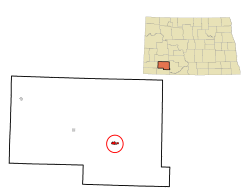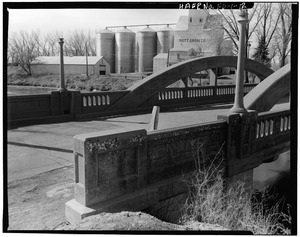Mott, North Dakota facts for kids
Quick facts for kids
Mott, North Dakota
|
|
|---|---|

Location of Mott, North Dakota
|
|
| Country | United States |
| State | North Dakota |
| County | Hettinger |
| Founded | 1904 |
| Area | |
| • Total | 0.92 sq mi (2.38 km2) |
| • Land | 0.92 sq mi (2.38 km2) |
| • Water | 0.00 sq mi (0.00 km2) |
| Elevation | 2,408 ft (734 m) |
| Population
(2020)
|
|
| • Total | 653 |
| • Estimate
(2022)
|
635 |
| • Density | 710.55/sq mi (274.46/km2) |
| Time zone | UTC-7 (Mountain (MST)) |
| • Summer (DST) | UTC-6 (MDT) |
| ZIP code |
58646
|
| Area code(s) | 701 |
| FIPS code | 38-54620 |
| GNIS feature ID | 1036171 |
Mott is a city in and the county seat of Hettinger County, North Dakota, United States. The population was 653 at the 2020 census.
History
Mott was founded in 1904 when territory was opened to settlers. There are conflicting stories of how the city was named. One theory is the city was named for Lillian Mott, the secretary of the town promoter, while the competing theory say the city was named for C. W. Mott, a railroad employee. A post office has been in operation at Mott since 1904.
A 1975 F4 tornado struck Mott, killing one and injuring four.
A distinctive symbol for Mott was the art deco arched "rainbow" bridge crossing the Cannonball River to the unincorporated area colloquially known as "West Mott". The arched bridge was damaged beyond repair in a 1997 flood.
Geography
According to the United States Census Bureau, the city has a total area of 0.90 square miles (2.33 km2), all land.
Climate
| Climate data for Mott, North Dakota | |||||||||||||
|---|---|---|---|---|---|---|---|---|---|---|---|---|---|
| Month | Jan | Feb | Mar | Apr | May | Jun | Jul | Aug | Sep | Oct | Nov | Dec | Year |
| Record high °F (°C) | 67 (19) |
71 (22) |
80 (27) |
95 (35) |
96 (36) |
106 (41) |
110 (43) |
108 (42) |
105 (41) |
95 (35) |
84 (29) |
67 (19) |
110 (43) |
| Mean daily maximum °F (°C) | 27 (−3) |
32 (0) |
42 (6) |
57 (14) |
67 (19) |
77 (25) |
85 (29) |
85 (29) |
73 (23) |
59 (15) |
42 (6) |
29 (−2) |
56 (13) |
| Mean daily minimum °F (°C) | 4 (−16) |
8 (−13) |
18 (−8) |
28 (−2) |
40 (4) |
50 (10) |
55 (13) |
53 (12) |
41 (5) |
29 (−2) |
18 (−8) |
6 (−14) |
29 (−2) |
| Record low °F (°C) | −42 (−41) |
−44 (−42) |
−33 (−36) |
−13 (−25) |
4 (−16) |
29 (−2) |
36 (2) |
31 (−1) |
12 (−11) |
−8 (−22) |
−25 (−32) |
−39 (−39) |
−44 (−42) |
| Average precipitation inches (mm) | 0.42 (11) |
0.77 (20) |
0.91 (23) |
1.7 (43) |
2.53 (64) |
2.85 (72) |
2.19 (56) |
1.52 (39) |
1.32 (34) |
1.28 (33) |
0.60 (15) |
0.50 (13) |
16.59 (423) |
| Source: The Weather Channel | |||||||||||||
Demographics
| Historical population | |||
|---|---|---|---|
| Census | Pop. | %± | |
| 1920 | 723 | — | |
| 1930 | 1,036 | 43.3% | |
| 1940 | 1,220 | 17.8% | |
| 1950 | 1,583 | 29.8% | |
| 1960 | 1,463 | −7.6% | |
| 1970 | 1,368 | −6.5% | |
| 1980 | 1,315 | −3.9% | |
| 1990 | 1,019 | −22.5% | |
| 2000 | 808 | −20.7% | |
| 2010 | 721 | −10.8% | |
| 2020 | 653 | −9.4% | |
| 2022 (est.) | 635 | −11.9% | |
| U.S. Decennial Census 2020 Census |
|||
2010 census
As of the census of 2010, there were 721 people, 315 households, and 191 families residing in the city. The population density was 801.1 inhabitants per square mile (309.3/km2). There were 415 housing units at an average density of 461.1 per square mile (178.0/km2). The racial makeup of the city was 97.9% White, 0.4% Native American, and 1.7% from two or more races.
There were 315 households, of which 21.6% had children under the age of 18 living with them, 53.0% were married couples living together, 7.0% had a female householder with no husband present, 0.6% had a male householder with no wife present, and 39.4% were non-families. 37.1% of all households were made up of individuals, and 23.2% had someone living alone who was 65 years of age or older. The average household size was 2.12 and the average family size was 2.75.
The median age in the city was 52.9 years. 20.4% of residents were under the age of 18; 3.6% were between the ages of 18 and 24; 15% were from 25 to 44; 27% were from 45 to 64; and 34% were 65 years of age or older. The gender makeup of the city was 47.2% male and 52.8% female.
Education
Mott shares the Mott/Regent School District, a unified school district with nearby Regent. Grades K-12 are located in Mott. The school districts's mascot is the Wildfire.
Prior to unification the Mott School District's mascot was the Cardinals.
Notable people
- James Bannon, Wisconsin state legislator and politician, moved to a farm in Mott in 1905.
- Eric Hardmeyer, president and CEO of the Bank of North Dakota
- James Kerzman, North Dakota state legislator, farmer, and rancher
- Melvin J. Miller, Minnesota state legislator and farmer
- Larry Woiwode, author and poet laureate of North Dakota
See also
 In Spanish: Mott (Dakota del Norte) para niños
In Spanish: Mott (Dakota del Norte) para niños


